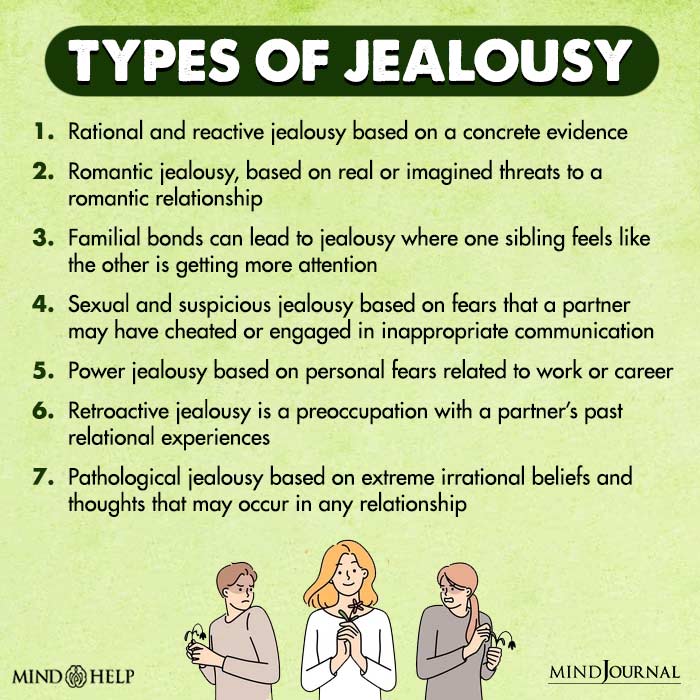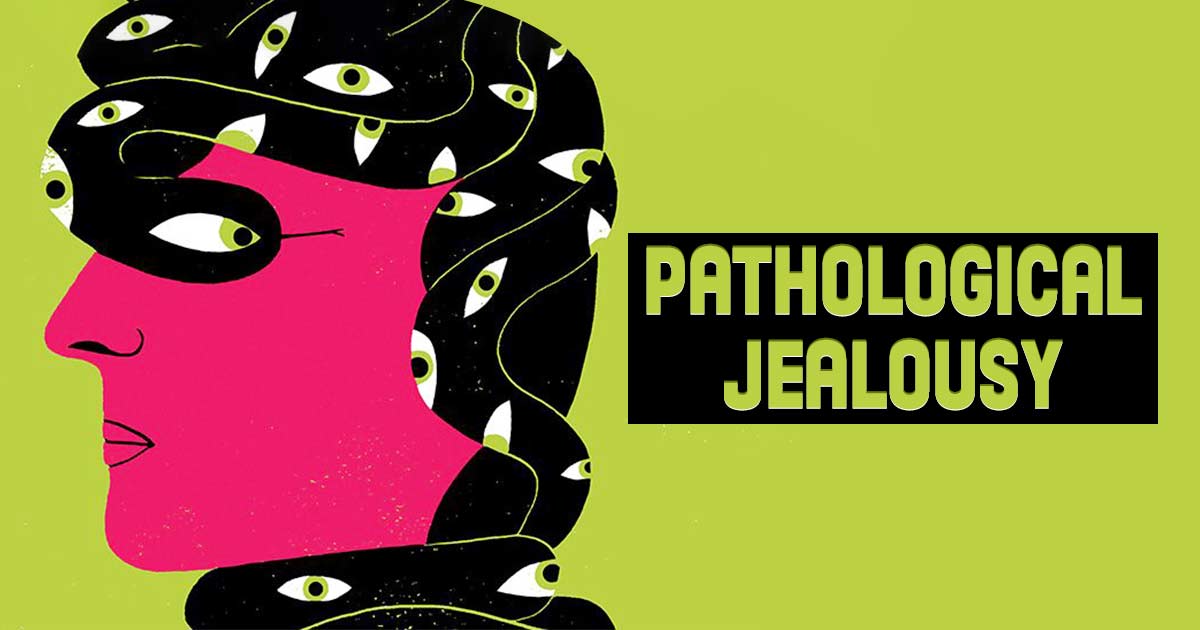Pathological jealousy is an extreme and irrational form of jealousy that can have a profound impact on an individual’s life and relationships. This pathological form of jealousy extends beyond what is considered usual and can result in intense distress, emotional instability, and even violent behavior.
What Is Pathological Jealousy?
Jealousy is a complex emotion that typically arises 1 Ramachandran, V. S., & Jalal, B. (2017). The Evolutionary Psychology of Envy and Jealousy. Frontiers in psychology, 8, 1619. https://doi.org/10.3389/fpsyg.2017.01619 from a perceived threat to a valued relationship or the fear of losing something or someone important.
Pathological jealousy, on the other hand, goes beyond the normal range of jealousy and encompasses a broader spectrum of jealous behavior. It extends beyond lack of trust in one’s partner and can manifest in various situations and relationships, irrespective of their nature.
Pathological jealousy is also known as morbid jealousy 2 Singh, S. K., Bhandari, S. S., & Singh, P. K. (2017). Phenomenology and predisposing factors of morbid jealousy in a psychiatric outdoor: a cross-sectional, descriptive study. Open journal of psychiatry & allied sciences, 8(2), 129–135. https://doi.org/10.5958/2394-2061.2017.00008.8 or delusional jealousy. This pathological jealousy examples often involves excessive suspicion, mistrust, and intense emotional reactions such as anger, hostility, and aggression irrespective of any situation or relationship.
Pathological jealousy is believed to affect approximately 0.5-1% of 3 Ortigue, S., & Bianchi-Demicheli, F. (2011). Intention, false beliefs, and delusional jealousy: insights into the right hemisphere from neurological patients and neuroimaging studies. Medical science monitor : international medical journal of experimental and clinical research, 17(1), RA1–RA11. https://doi.org/10.12659/msm.881314 the global population. However, jealousy is a common human emotion, it becomes pathological when it reaches extreme levels and begins to interfere with daily activities, relationships, and overall quality of life, such as work, socializing, and self-care.
Read More About Relationships Here

Signs of Pathological Jealousy
Some pathological jealousy signs include 4 Ortigue, S., & Bianchi-Demicheli, F. (2011). Intention, false beliefs, and delusional jealousy: insights into the right hemisphere from neurological patients and neuroimaging studies. Medical science monitor : international medical journal of experimental and clinical research, 17(1), RA1–RA11. https://doi.org/10.12659/msm.881314 :
- Constant, intrusive thoughts about their partner’s loyalty
- Excessively monitor the activities, interactions, or achievements of others whether partners, friends, or colleagues
- They may constantly measure their own success, appearance, or abilities against those of others
- They may become angry or upset if their partner wants to spend time with other people
- They may try to control others’ actions and behaviors, such as what they wear or where they go
- They may try to isolate their partner from friends and family
- Hostile and aggressive behavior, such as confrontations, verbal attacks, or even physical violence to dominate others
- Blaming the cause of one’s jealous behavior on the others
How Does Pathological Jealousy Affect Mental Health?
There are various ways in which pathological jealousy can impact an individual’s mental health 5 Masiran, R., & Hussin, N. S. (2018). Morbid jealousy reactivated by mood episodes. BMJ case reports, 2018, bcr2017223430. https://doi.org/10.1136/bcr-2017-223430 functioning in daily life, such as:
- Persistent feelings of anxiety, fear, and insecurity
- Difficulty concentrating and focusing on tasks
- Sleep disturbances, such as insomnia or nightmares
- Changes in appetite and eating habits
- Social isolation and withdrawal from friends and family
- Difficulty with trust and forming close relationships
- Low self-esteem and self-worth
- Mood swings, such as sudden shifts in emotional states, ranging from sadness and despair to anger and hostility
- Substance abuse and other forms of self-destructive behavior

Causes of Developing Pathological Jealousy
Here are some factors 6 Singh, S. K., Bhandari, S. S., & Singh, P. K. (2017). Phenomenology and predisposing factors of morbid jealousy in a psychiatric outdoor: a cross-sectional, descriptive study. Open journal of psychiatry & allied sciences, 8(2), 129–135. https://doi.org/10.5958/2394-2061.2017.00008.8 that may contribute to or potentially cause the development of pathological jealousy:
- Childhood experiences such as neglect, abuse, or witnessing parental conflict
- Trauma or betrayal in past relationships
- Relationship factors such as long-distance, infidelity, or lack of emotional intimacy
- Feeling insecure and having low self-esteem
- Personality traits such as impulsivity, aggression, or low emotional stability
Read More About Adverse Childhood Experiences Here
Diagnosing Pathological Jealousy
To diagnose the pathological jealousy signs, a mental health 7 Graff-Radford, J., Whitwell, J. L., Geda, Y. E., & Josephs, K. A. (2012). Clinical and imaging features of Othello’s syndrome. European journal of neurology, 19(1), 38–46. https://doi.org/10.1111/j.1468-1331.2011.03412.x professional will typically follow these steps:
1. Initial Assessment
The professional evaluates the individual’s symptoms, medical history, and other relevant information through a clinical interview, physical examination, and review of medical records.
2. Psychological Evaluation
The professional conducts a psychological assessment 8 Ventura-León, J., & Lino-Cruz, C. (2023). Love, jealousy, satisfaction and violence in young couples: A network analysis. PloS one, 18(5), e0285555. https://doi.org/10.1371/journal.pone.0285555 such as the Multidimensional jealousy scale (MJS), and Questionnaire on affective relationships (QAR) to evaluate cognitive, emotional, and behavioral functioning.
3. Assess for Potential Causes
The professional evaluates for other potential causes of the individual’s symptoms, such as medical conditions, substance abuse, or other psychiatric disorders.
4. Involve Family
The professional may involve the individual’s partner or family members to gain a broader understanding of pathological jealousy expressed by him or her and their relational dynamics.
Read More About Family Here
5. Develop a Treatment Plan
Once a diagnosis is made, the professional works with the person to develop an individualized treatment plan.
Treatment for Pathological Jealousy
Some common pathological jealousy treatment 9 Gross M. D. (1991). Treatment of pathological jealousy by fluoxetine. The American journal of psychiatry, 148(5), 683–684. https://doi.org/10.1176/ajp.148.5.683b measures include:
- Cognitive-behavioral therapy (CBT) helps individuals recognize and modify negative thoughts and behaviors associated with jealousy.
- Mindfulness-based therapy helps to reduce stress and anxiety.
- Couples therapy helps in solving jealousy-related issues, such as resolving communications, personal insecurities, and impulsive reactions.
- Certain medications, such as antidepressants or anti-anxiety medication, may be prescribed by psychiatrists for pathological jealousy, especially if it accompanies other mental health conditions like anxiety or depression.
- Group therapy or support groups offer a supportive community for individuals facing similar challenges, providing a chance to share experiences, gain insights, and learn from others.
Read More About CBT Here
Loving and Living with Someone with Pathological Jealousy
Living and loving someone with pathological jealousy presents unique challenges and can be emotionally distressing. Successfully managing 10 Maninger, N., Mendoza, S. P., Williams, D. R., Mason, W. A., Cherry, S. R., Rowland, D. J., Schaefer, T., & Bales, K. L. (2017). Imaging, Behavior and Endocrine Analysis of “Jealousy” in a Monogamous Primate. Frontiers in ecology and evolution, 5, 119. https://doi.org/10.3389/fevo.2017.00119 this situation requires a combination of understanding, patience, and open communication to navigate the complexities that arise.
Additionally, in cases of extreme abuse and physical violations, seeking assistance from local NGOs and community organizations becomes crucial. It is important to recognize that pathological jealousy can have significant impacts 11 Stravogiannis, A. L. D. C., Kim, H. S., Sophia, E. C., Sanches, C., Zilberman, M. L., & Tavares, H. (2018). Pathological jealousy and pathological love: Apples to apples or apples to oranges?. Psychiatry research, 259, 562–570. https://doi.org/10.1016/j.psychres.2017.11.029 on the emotional and mental well-being of the individual affected, including:
- Constant feelings of anxiety, stress, and fear due to the jealous partner’s accusations.
- Low self-esteem and self-worth, as the jealous partner may criticize and belittle the other person.
- Social isolation and loss of personal relationships, as the jealous partner may limit or prohibit the other person’s interactions with friends and family.
- Physical and emotional abuse, which can cause long-term trauma and psychological damage.
- Difficulty maintaining a healthy relationship due to extreme and irrational jealousy.
Tips to Cope with Pathological Jealousy
Consider the following tips to cope 12 Seeman, M. V. (2016). Pathological Jealousy: An Interactive Condition. Psychiatry, 79(4), 379–388. https://doi.org/10.1080/00332747.2016.1175838 with pathological jealousy:
- Communicate your feelings and concerns in a calm and respectful way.
- Try to identify the triggering feelings and experiences that contribute to the significant amount of jealousy.
- Reach out to friends, family, or a mental health professional for support.
- If you are experiencing significant emotional distress due to pathological jealousy, consider seeking therapy.
- Try not to act on your suspicions and focus on building trust with your partner through open conversation.
- Keep a gratitude journal that involves writing down things you are thankful for to get over the feelings of jealousy.
- Prioritize self-care activities that help you relax and reduce stress, such as exercise and hobbies.
- Since these feelings develop over time, giving yourself time to deal with them is crucial.
Takeaway
Living with someone who has pathological jealousy can be challenging, and it is essential to prioritize personal safety and seek professional help when necessary.
It is also crucial to set boundaries and communicate clearly with the individual about their behavior and its impact on the relationship. With proper pathological jealousy treatment and support, it is possible to manage and overcome pathological jealousy and build healthier relationships based on trust and mutual respect.
At A Glance
- Pathological jealousy is a complex condition characterized by persistent feelings of jealousy and possessiveness.
- It can have a significant impact on an individual’s mental health and relationships, causing depression, anxiety, and mood swings.
- Causes of pathological jealousy can include mental health conditions, childhood experiences, and relationship dynamics.
- Diagnosis typically involves an initial assessment by a mental health professional, including a clinical interview, and physical and psychological examination.
- Treatment may involve a combination of psychotherapy, medication, and lifestyle changes.
- Living with someone who has pathological jealousy can be challenging.
- With proper treatment and support, it is possible to manage and overcome pathological jealousy and build healthier relationships.
Frequently Asked Questions (FAQs)
1. What to do if a partner has pathological jealousy?
When dealing with a partner who has pathological jealousy, seeking professional help from a mental health provider is crucial. It’s essential to establish healthy boundaries, communicate openly and honestly with your partner, and practice self-care while seeking support from loved ones.
2. What are the three types of jealousy?
The three types of jealousy are normal jealousy, suspicious jealousy, and pathological jealousy. Normal jealousy is a common and mild form of jealousy that may arise in a relationship, while suspicious jealousy involves unfounded suspicions of infidelity. Pathological jealousy is an extreme and irrational form of jealousy that can have serious negative impacts on a person’s mental health and relationships.
3. What is the Behaviour of jealousy?
The behavior of jealousy can vary widely depending on the individual and the circumstances. However, common behaviors associated with jealousy include suspicion, possessiveness, insecurity, violations, and controlling behaviors.
References:
- 1Ramachandran, V. S., & Jalal, B. (2017). The Evolutionary Psychology of Envy and Jealousy. Frontiers in psychology, 8, 1619. https://doi.org/10.3389/fpsyg.2017.01619
- 2Singh, S. K., Bhandari, S. S., & Singh, P. K. (2017). Phenomenology and predisposing factors of morbid jealousy in a psychiatric outdoor: a cross-sectional, descriptive study. Open journal of psychiatry & allied sciences, 8(2), 129–135. https://doi.org/10.5958/2394-2061.2017.00008.8
- 3Ortigue, S., & Bianchi-Demicheli, F. (2011). Intention, false beliefs, and delusional jealousy: insights into the right hemisphere from neurological patients and neuroimaging studies. Medical science monitor : international medical journal of experimental and clinical research, 17(1), RA1–RA11. https://doi.org/10.12659/msm.881314
- 4Ortigue, S., & Bianchi-Demicheli, F. (2011). Intention, false beliefs, and delusional jealousy: insights into the right hemisphere from neurological patients and neuroimaging studies. Medical science monitor : international medical journal of experimental and clinical research, 17(1), RA1–RA11. https://doi.org/10.12659/msm.881314
- 5Masiran, R., & Hussin, N. S. (2018). Morbid jealousy reactivated by mood episodes. BMJ case reports, 2018, bcr2017223430. https://doi.org/10.1136/bcr-2017-223430
- 6Singh, S. K., Bhandari, S. S., & Singh, P. K. (2017). Phenomenology and predisposing factors of morbid jealousy in a psychiatric outdoor: a cross-sectional, descriptive study. Open journal of psychiatry & allied sciences, 8(2), 129–135. https://doi.org/10.5958/2394-2061.2017.00008.8
- 7Graff-Radford, J., Whitwell, J. L., Geda, Y. E., & Josephs, K. A. (2012). Clinical and imaging features of Othello’s syndrome. European journal of neurology, 19(1), 38–46. https://doi.org/10.1111/j.1468-1331.2011.03412.x
- 8Ventura-León, J., & Lino-Cruz, C. (2023). Love, jealousy, satisfaction and violence in young couples: A network analysis. PloS one, 18(5), e0285555. https://doi.org/10.1371/journal.pone.0285555
- 9Gross M. D. (1991). Treatment of pathological jealousy by fluoxetine. The American journal of psychiatry, 148(5), 683–684. https://doi.org/10.1176/ajp.148.5.683b
- 10Maninger, N., Mendoza, S. P., Williams, D. R., Mason, W. A., Cherry, S. R., Rowland, D. J., Schaefer, T., & Bales, K. L. (2017). Imaging, Behavior and Endocrine Analysis of “Jealousy” in a Monogamous Primate. Frontiers in ecology and evolution, 5, 119. https://doi.org/10.3389/fevo.2017.00119
- 11Stravogiannis, A. L. D. C., Kim, H. S., Sophia, E. C., Sanches, C., Zilberman, M. L., & Tavares, H. (2018). Pathological jealousy and pathological love: Apples to apples or apples to oranges?. Psychiatry research, 259, 562–570. https://doi.org/10.1016/j.psychres.2017.11.029
- 12Seeman, M. V. (2016). Pathological Jealousy: An Interactive Condition. Psychiatry, 79(4), 379–388. https://doi.org/10.1080/00332747.2016.1175838










